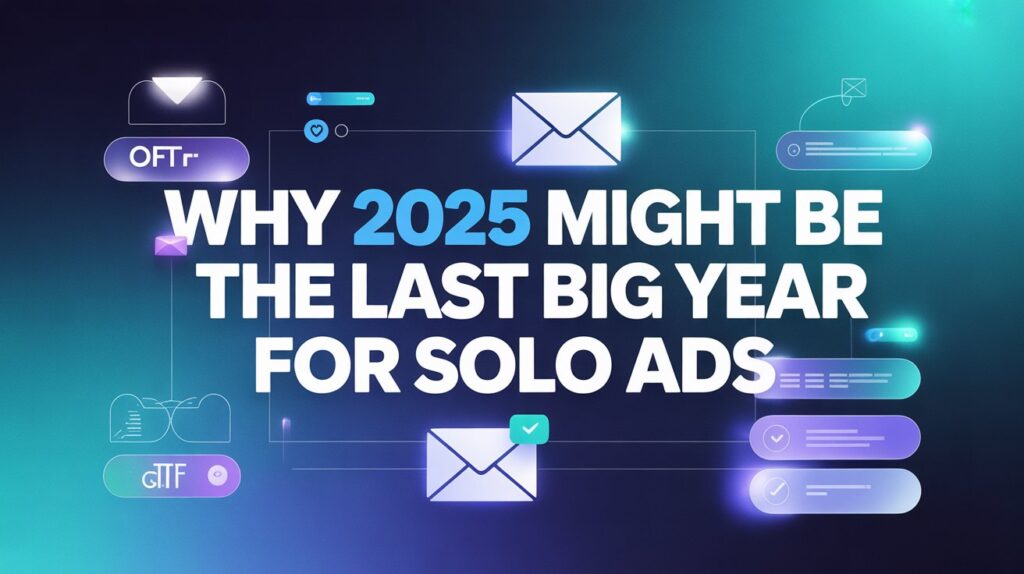
2025 may become a Big Year for Solo Ads turning point for the solo ads industry. Rapid algorithm changes, AI-driven targeting, stricter email regulations, and shifts in buyer behavior are reshaping how online marketers build email lists. This post explores why 2025 might be the final explosive year for solo ads—and how marketers can leverage this channel before it changes forever.
Table of Contents
The Rise of AI and How It’s Replacing Traditional Solo Ad Strategies
Artificial intelligence is rapidly transforming lead generation. Tools like AI-driven funnels, behavior-based email automation, and predictive targeting are making solo ads less essential for list building.
AI platforms can now:
Identify high-intent leads better than a typical solo ad list owner.
Segment users based on micro-behaviors in real time.
Generate personalized funnels that outperform generic solo-ad traffic.
Example:
A marketer spending $300 on solo ads may get 150–200 opt-ins with varying engagement. But an AI funnel using behavior-triggered ads may produce higher-quality leads at a similar or lower cost. By 2025, these tools are more accessible, reducing dependence on traditional solo ad vendors.
Email Deliverability Is Becoming Stricter—and It Hurts Solo Ad Traffic
2024–2025 brought a surge in new email compliance guidelines from Gmail, Yahoo, and Apple. These include:
Higher authentication requirements
Lower tolerance for bulk email sends
Quicker spam-flagging systems
Solo ad lists—often blasted to thousands—are hit the hardest.
Example:
A vendor with 50K subscribers can no longer send multiple promos daily without deliverability drops. As inbox providers tighten controls, solo ad clicks may decline in quality and consistency.
This makes 2025 a critical year before more aggressive filtering becomes the new normal.
The Market Is Saturated and Users Are Becoming “Ad Blind”
Thousands of new list builders and affiliate marketers have entered the solo ads space since 2020. As a result:
Subscribers receive more emails per day
They develop “promo fatigue”
Opt-in rates slowly decline
Buyers are wiser, and many now recognize overly promotional email styles—making them less responsive.
Example:
A funnel that converted at 40% opt-in in 2022 might now only convert at 25–30% using the same swipe. This trend shows that the era of cheap, easy conversions is coming to an end.
Solo Ad Vendors Are Increasing Prices Faster Than Results
As demand grows but list quality stagnates, vendors are increasing their prices to maintain profit margins.
In 2025, many vendors charge:
$0.90–$1.50 per click
Extra fees for tier-1 traffic
Premiums for “fresh lists” or guaranteed sales
But marketers report that conversion rates aren’t improving proportionally.
Example:
A beginner marketer buys 300 clicks for $270 at $0.90 per click but generates only 12–15 leads that actually engage. This mismatch is making solo ads less sustainable—especially for newcomers.
Social Platforms Are Offering Better Targeting for Less
Meta, TikTok, YouTube, and even Pinterest now offer hyper-precise targeting tools that outperform broad solo ad lists.
These platforms give:
Real-time analytics
Behavioral targeting
Creative testing
Retargeting capabilities
Solo ads provide none of these.
Example:
A marketer can spend $150 on TikTok ads and get better-targeted traffic and cheaper leads than a $150 solo ad run. In 2025, this gap continues widening, pushing many marketers to switch.
The Shift Toward First-Party Data Is Reducing the Power of Shared Lists
Regulations like GDPR and CCPA have increased the importance of owning first-party data. Solo ads rely on third-party lists—subscribers who never directly opted into your brand.
This creates:
Lower trust
Higher unsubscribe rates
Shorter subscriber lifetime value
Example:
A subscriber who opts in through a personal ad campaign stays on your list longer compared to a generic solo ad lead. Marketers are learning this and shifting strategies accordingly.
2025 might be the final year solo ads remain widely tolerated before regulatory pressure forces changes.
Why 2025 Is the “Last Big Year”—and How Smart Marketers Should Respond
Combining all the above factors, 2025 is shaping up to be the last peak year for solo ads before:
AI systems dominate the traffic landscape
Prices climb beyond practical
Email deliverability weakens solo ad sends
Social ads become cheaper and smarter
Regulations push marketers to first-party strategies
Marketers who strike now can still:
Build large lists quickly
Test funnels affordably
Scale fast before demand drops
Example Strategy:
Use solo ads for list-building only in 2025 while transitioning to:
Retargeting ads
AI funnel optimization
First-party lead sources
Organic authority-building
This hybrid approach allows you to gain the best of both worlds without relying exclusively on a channel that may decline soon.
Conclusion
2025 may very well be the last explosive year for the solo ads industry. With AI disrupting lead generation, stricter email regulations, rising click prices, and new advertising alternatives emerging, the landscape is shifting fast. Solo ads are not disappearing overnight—but they are becoming less dominant and more expensive. By leveraging solo ads now while preparing for the future with smarter, diversified strategies, marketers can stay ahead of the curve and protect their business from becoming obsolete.
FAQs
Yes—2025 may actually be one of the best years to use them before the market becomes saturated or too expensive. But they should not be your only source of traffic.
AI targeting, stricter email regulations, and better social ad alternatives are reshaping the lead generation landscape and reducing the effectiveness of shared email lists.
Absolutely, but they should use a proven funnel, high-converting lead magnet, and strong follow-up email sequence to maximize results.
Most marketers start with $100–$300 to test vendors. Scaling should only happen after identifying consistent, high-quality providers.
Make money online, affiliate marketing, crypto education, personal development, and email marketing are the strongest niches for solo ads.